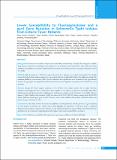Please use this identifier to cite or link to this item:
https://hdl.handle.net/20.500.14356/916| Title: | Lower Susceptibility to Fluoroquinolones and a gyrA Gene Mutation in Salmonella Typhi Isolates from Enteric Fever Patients |
| Authors: | Shrestha, Surya Kumari Khadka, Sujan Rayamajhee, Binod Thapa, Alina Sharma, Suprina Shrestha, Basudha Poudel, Pramod |
| Citation: | ShresthaS. K., KhadkaS., RayamajheeB., ThapaA., SharmaS., ShresthaB., & PoudelP. (2022). Lower Susceptibility to Fluoroquinolones and a gyrA Gene Mutation in Salmonella Typhi Isolates from Enteric Fever Patients . Journal of Nepal Health Research Council, 20(02), 517-523. https://doi.org/10.33314/jnhrc.v20i02.4245 |
| Issue Date: | 2022 |
| Publisher: | Nepal Health Research Council |
| Keywords: | Antibiotics susceptibility Fluoroquinolones; gyrA Gene; nalidixic acid; Salmonella? Typhi |
| Series/Report no.: | April-June, 2022;4245 |
| Abstract: | Abstract Background: Enteric fever remains a major cause of morbidity and mortality in Nepal. The emergence of multi-drug resistant Salmonella is a challenge to the clinician to care for patients with enteric fever. This study assessed the antibiotic susceptibility of Salmonella Typhi isolated from enteric fever and the presence of gyrA? ?gene mutation at ser83 of S. Typhi. Methods: Blood samples (n = 834) from suspected enteric fever patients were collected and cultured to identify Salmonella Typhi. Antimicrobial sensitivity test was performed by the modified Kirby Bauer disc diffusion method. The minimum ?inhibitory concentration (MIC) tests for ofloxacin and ciprofloxacin were examined by the agar dilution method. The gyrA gene was amplified by PCR and restriction enzyme digestion was performed to evaluate the ser83 mutation. Results: Among 824 blood samples analyzed, 5.1% (42/824) were culture positive for S. Typhi. First-line antibiotics chloramphenicol and co-trimoxazole showed higher in-vitro efficacy compared to amoxicillin. Macrolides (azithromycin) and third-generation cephalosporins (ceftriaxone, cefixime, and cefotaxime) were highly effective against S. Typhi. Nalidixic acid resistance (NAR) was observed in 95.2% (40/42) isolates, among them, all (40/40) isolates harbored mutant gyrA gene at ser83. However, none of the nalidixic acid-sensitive Salmonella? isolates was positive for gyrA? mutation at ser83. Conclusions: This study showed decreased susceptibility to fluoroquinolones and the presence of gyrA? mutation at ser83 position in majority of S. Typhi isolates which highlights the importance of alternate drugs as empirical therapy for the treatment of enteric fever patients. So, the clinician should focus on prescribing conventional first-line antibiotics for the treatment of typhoid patients after higher cohort and extended follow-up studies. Keywords: Antibiotics susceptibility; fluoroquinolones; gyrA? gene; nalidixic acid; Salmonella? Typhi |
| Description: | Original Article |
| URI: | http://103.69.126.140:8080/handle/20.500.14356/916 |
| ISSN: | Print ISSN: 1727-5482; Online ISSN: 1999-6217 |
| Appears in Collections: | Vol 20 No 02 Issue 55 April-June, 2022 |
Files in This Item:
| File | Description | Size | Format | |
|---|---|---|---|---|
| 4245-Manuscript-29709-1-10-20221103.pdf | Full Article. | 721.87 kB | Adobe PDF |  View/Open |
Items in DSpace are protected by copyright, with all rights reserved, unless otherwise indicated.
